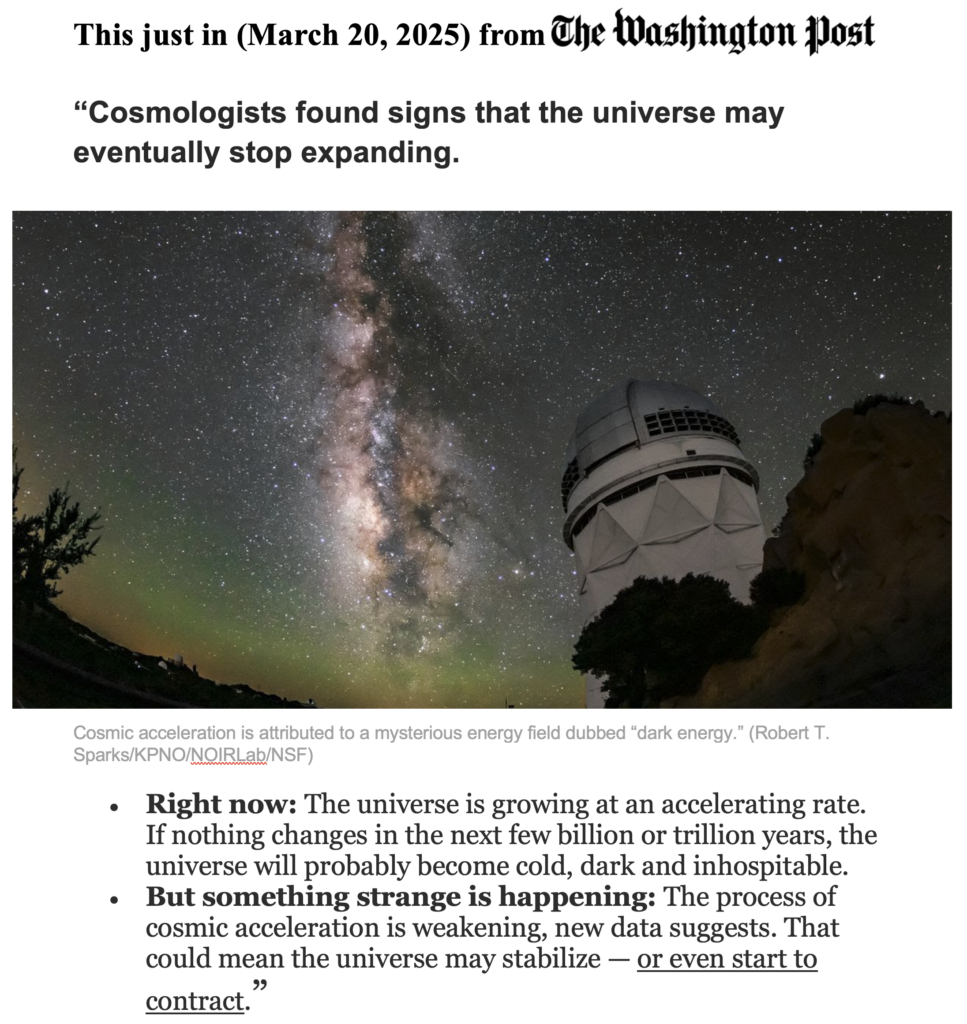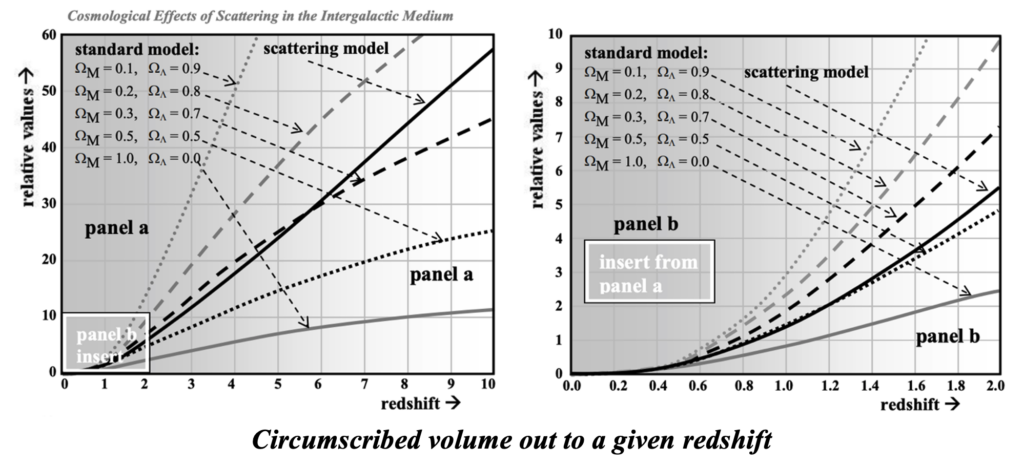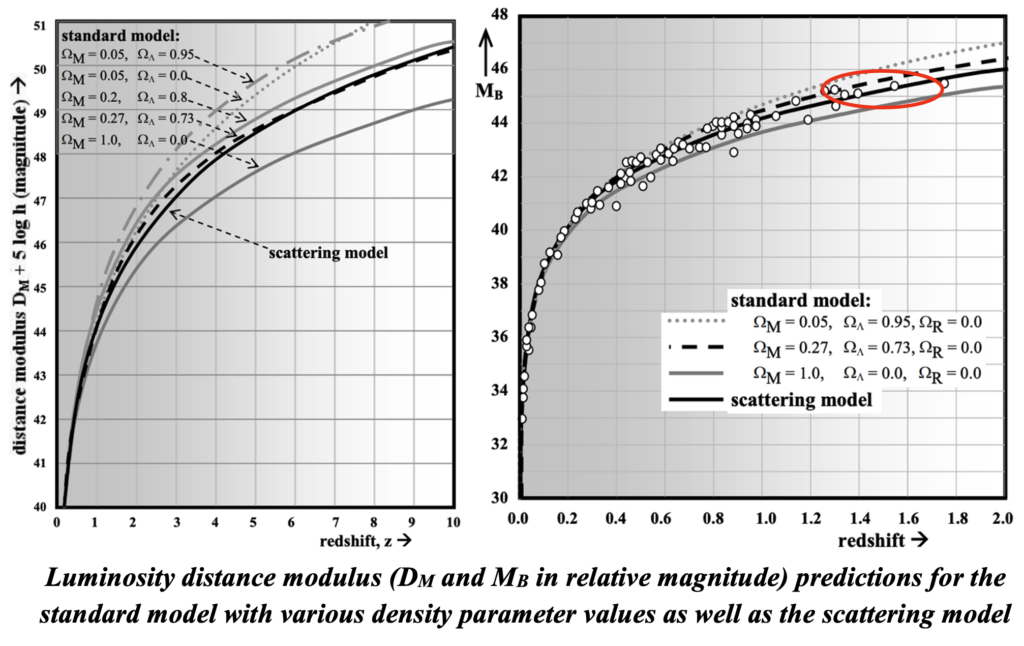
Well, isn’t that just… something?
No. No, it isn’t something… real; it is a misinterpretation of data attempting to force the universe into a model in which it does not fit. Cosmologists continues the irrational trend of what I quoted in my book Cosmological Effects Of Scattering In The Intergalactic Medium (available here). What I quoted was from Geller and Peebles (1972) duplicated below.
“… the reasons for the widespread acceptance of the expansion hypothesis is the lack of a reasonable alternative basis for redshift…We ask whether a tired-light cosmology can do as well. If it cannot, the result may be interpreted as evidence for expansion. Of course, the evidence would not be conclusive, for in the absence of even a tentative physical basis for the tired-light effect we are free to add as many embellishments as necessary to secure agreement with observation. Therefore, adequate establishment of the case is a matter of judgment.”
The so-called ‘standard’ model is a repeatedly retro-fitted explanation (’embellishment’ if you must) of observations that do not agree with the theoretical expansion model.
As I stated then in my book:
“This is logic gone amok! Failure of an alternative is not tantamount to success in any truly scientific arena. And yet… this logic has continued to hold sway. Although to the author’s knowledge no viable ‘tired light’ model has previously been put forward, after eighty years cosmologists still argue in papers coauthored by huge numbers of researchers against the silent ‘tired light’ contingent – no doubt because of its obvious inherent appeal. See for example Blondin et al. (2008). In any case more than thirty-five years after Geller and Peeble’s quoted statement above, two things are now certain: standard models have indeed continued to be embellished and a tired-light model has finally been given a physical basis that accounts for observations at least as well as any “embellished” version of the standard cosmological model. Cosmological redshift no longer justifies retention of Hubble’s recessional velocity, or otherwise characterized expansion, hypothesis. The luminosity-redshift data is precisely in agreement with the scattering model. Nor does the ad hoc assumption that billions of times the mass of our entire universe was required to produce the 2.725 K microwave background radiation make any sense at all. It is too easily accounted as the byproduct of the fusion required to produce the 24% helium from the ubiquitous primordial hydrogenous plasma, which accords well with the observed temperature and density of the universe around us. So there seems to be no residual unaccounted phenomena to support the standard model although the list of claims to the contrary against any and all tired light alternatives continues unabated.”
…
“There would seem to be too few reasons to retain the more radical theoretical accouterments of the standard cosmological model, including emergence of our entire universe from nothing and a still physically unjustifiable inflationary phase that defies all physical laws to get it kick started. There is no need to resurrect Einstein’s “greatest error” that was incorrect for more reasons than the one of which he became aware, just to account for ‘dark matter’. The sordid history of that artifact is one of intrigue in fudging formulas to fit data. And the ever so mysterious ‘dark energy’ that is supposed to propel a phased ‘acceleration’ was only hypothesized because none of the standard models could precisely match the magnitude-redshift plots of distant SN1A supernova data which is fit precisely by the scattering model. Absolutely no valid rationale can be given for the conjectured mysterious energy. All these co-dependent props are engaged in defending an indefensible model that defies and mocks the very physics from which valid models derive. Proponents argue based on anthropic principles with regard to a ‘multiverse’ of universes somewhat like our own but with totally different physical laws and universal constants. All these professor Panglosses profess that “we live in the best of all these possible worlds” where physics happens to work, when in fact, it seems quite certain that we live in the only possible universe.”
So, what is the data that requires the universe to obey this man-made law of expansion?
First of all, why did Riess et al. (1998) decide that the universal expansion must have accelerated? To answer that, one must realize that the ‘quote’ standard model is really a family of models that depend on the mass density of the universe and that is because the universe was quite erroneously considered to be controlled primarily by gravitation rather than primarily (or at least equally) by thermodynamic considerations. And the percentage of the total density that is regular-old-periodic-table kind of mass (omega-sub-m) or unknown ‘dark’ matter (omega-sub-gamma) has an impact as shown in the charts below. To force a best fit of this model to the data a concensus, now called the ‘DeltaCDM model’ for ‘cold-dark-matter’, is the only one of these alternatives that is anywhere close to the observations of phenomena at larger and larger redshifts. In the following redshift-volume element plots, the dark dashed line represents the DCDM version of the model. The solid dark line represents the plasma scattering model’s predicted size of these elemental volumes as a function of redshift, requiring no assumption other than intergalactic plasma density and temperature.

What is apparent in these plots, is also apparent in the magnitude-redshift curves below:

The original standard model does not accommodate a version that fits the data beyond a redshift of 1.0 as shown in the red oval in the right-hand figure. Either the model must be rejected or ‘embellished’ by changing the universe into one that accelerates expansion after a redshift of unity. That is the option which Reiss took and for which he received a Nobel prize. Clearly, he accepted the wrong option. The scattering model provides a very precise fit to the data for all redshifts.
Significantly, it is obvious in the data that as the DCDM model curve continues to bend for the redshifts beyond 2.0, there will be a requirement for accelerated expansion to be over. That is what we read in the Washington Post today. At a redshift of five or six it will require that the universe decelerate. I think we know what will happen as the Webb telescope provides glimpses of the universe at redshifts beyond three or four.
Leave a Reply